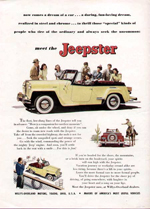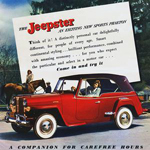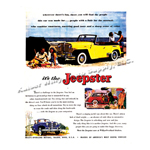

In 1908, John North Willys purchased the Overland Automotive Company, based in Indianapolis, Indiana. Within a year, the company was renamed Willys-Overland and was operating out of a larger plant in Toledo, Ohio. By 1912 they had become America’s second-largest car producer, following Ford.
Willys was contracted to build military Jeeps for the war, manufacturing approximately 360,000 vehicles by 1945. After the war, Willys-Overland was eager to resume production of vehicles for the civilian market, and the new 1948 Willys Jeepster VJ-2 was introduced to the public in July 1948. Only 10,326 of the 1948 Jeepsters were produced.
The base price of $1,765 included many features that were an extra cost on competitor’s cars, such as 5.90 × 15 whitewall tires, hubcaps with bright trim rings, front bumper guards, dual horns, deluxe steering wheel, cigar lighter, dual sun visors, locking glovebox, wind wings, top boot and a continental spare tire with cover.
Unfortunately, sales were not as expected. Many of the 10,326 Jeepsters were retitled as 1949 models. Willys-Overland took several steps to improve the Jeepster’s competitive position. Price was believed to be the greatest objection, so the 1949 Jeepster had a much lower price tag.
The 1949 VJ-3 was released with a base price of $1,495. Whitewall tires, wheel trim rings, T-shape grill trim, bumper guards, and second horn were now extra-cost options.


An additional Jeepster powered by a new six-cylinder engine, the VJ3-6, was added to the lineup toward the middle of the year. It featured the smallest six on the market, an L-head of 148.5 cid producing 72 bhp, but it offered greater smoothness than the four. Willys priced the six-cylinder Jeepster at $1,530. Jeepster sales picked up for a while, but production for 1949 totaled only 2,960 units. Of these, 2,307 were equipped with the four-cylinder engine and 653 with the new six.


Because the new models arrived midyear, there were two series of 1950 Jeepsters. The earlier, first-series fours were designated VJ-3 463; the first-series sixes were VJ-3 663. Jeepsters carrying the new four-cylinder engine and revamped styling, including the new grill with five horizontal chrome bars, were designated VJ-473, while six-cylinder models were VJ-673. Total 1950 Jeepster production was 5,845 units, of which 4,066 were four-cylinder models, and 1,779 were sixes. Even though production increased a bit, sales remained below expectation.
Poor marketing efforts and sparse advertising didn’t help increase sales, so the decision was made to cease production of the Jeepster. Willys, stuck with a number of unsold Jeepsters, decided to again retitle the leftovers selling them in the 1951 model year. There are said to be claims that maybe nine actual 1951 Jeepsters were produced to use up leftover parts. Despite the three year production run from 1948 – 1950, the Jeepster never caught on with the general public. A total of 19,131 Jeepsters were produced.
In 1953, Willys Overland was purchased by Henry J. Kaiser of Kaiser Frazer Corporation and changed the name to Willys Motor Company. In 1963 the company changed its name to Kaiser-Jeep Corporation. The Willys name was retired along with the production of the Willys wagons and trucks in 1965.
The Jeepster has resurfaced twice since 1951. In 1962, the original designer, Brooks Stevens, created a restyled version for possible production in Brazil. Unfortunately, the factory lacked sufficient capacity, and the project had to be dropped.


In 1967, Kaiser-Jeep introduced an all-new Jeepster. Sharing almost no parts with the original, the new four-wheel-drive Jeepster and Jeepster Commando enjoyed some success before being replaced by the Jeep Cherokee in 1974.


American Motors Corporation took over Kaiser-Jeep in 1970. They were purchased by Chrysler Corporation in 1987. Merging with Daimler-Benz in 1998, DaimlerChrysler was the fifth largest automaker in the world.
In 2007 Daimler Chrysler sold an 80% stake in the Chrysler division to Cerberus Capital, creating Chrysler LLC.
We can paint to original color specs or any color of your choice. The chart shows the color choices available for the Willys-Overland products during the production of the Jeepster.

